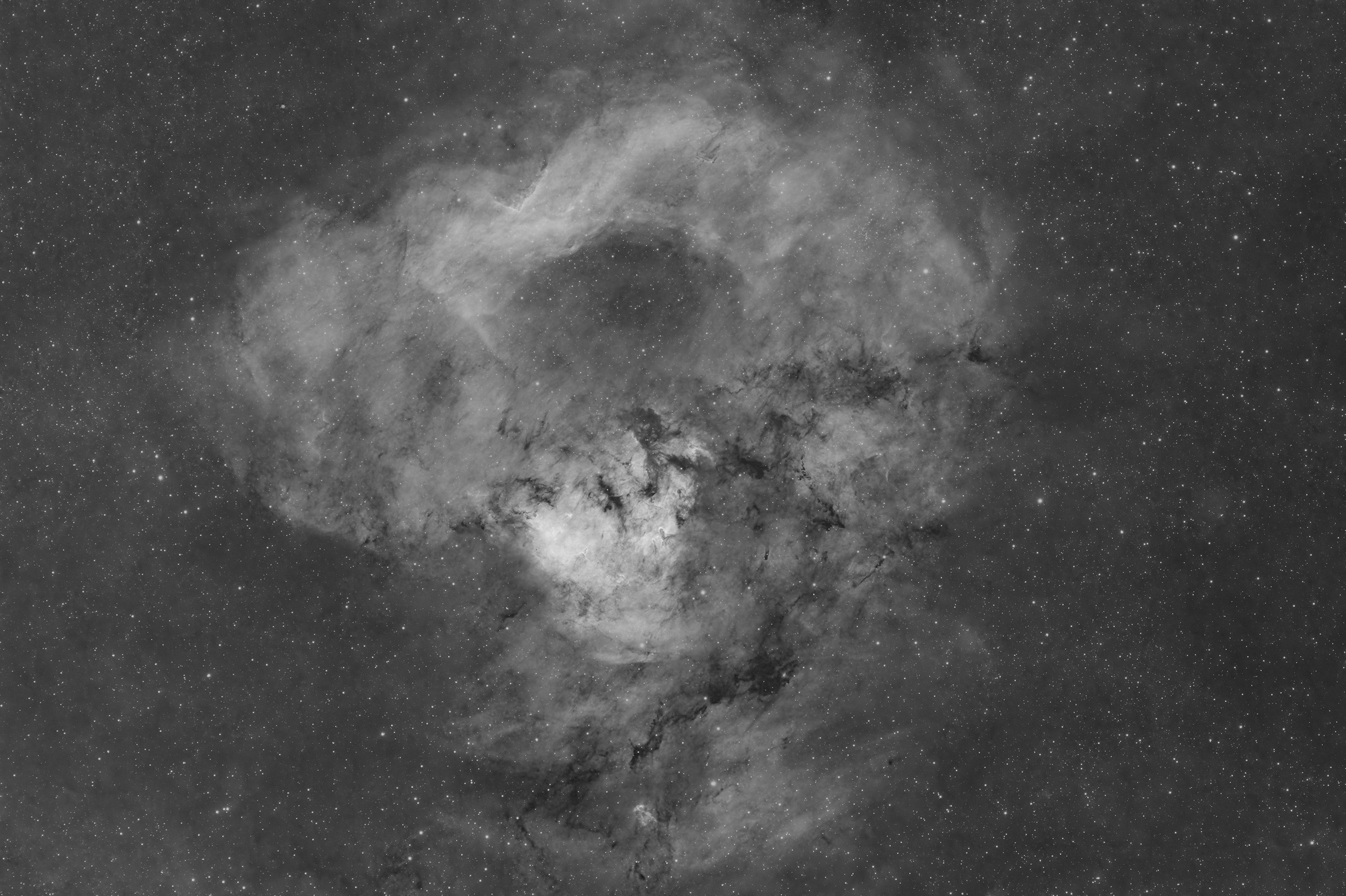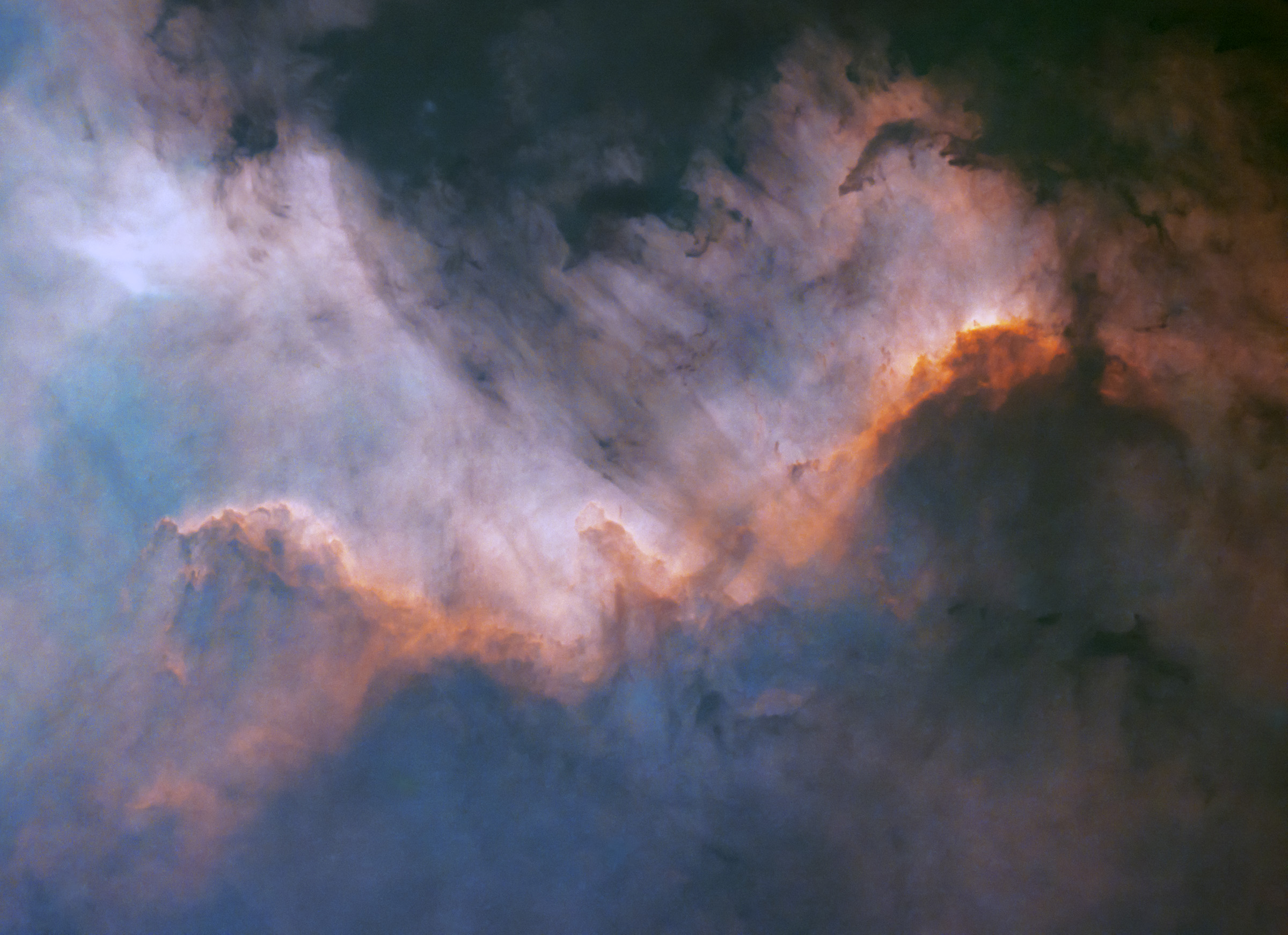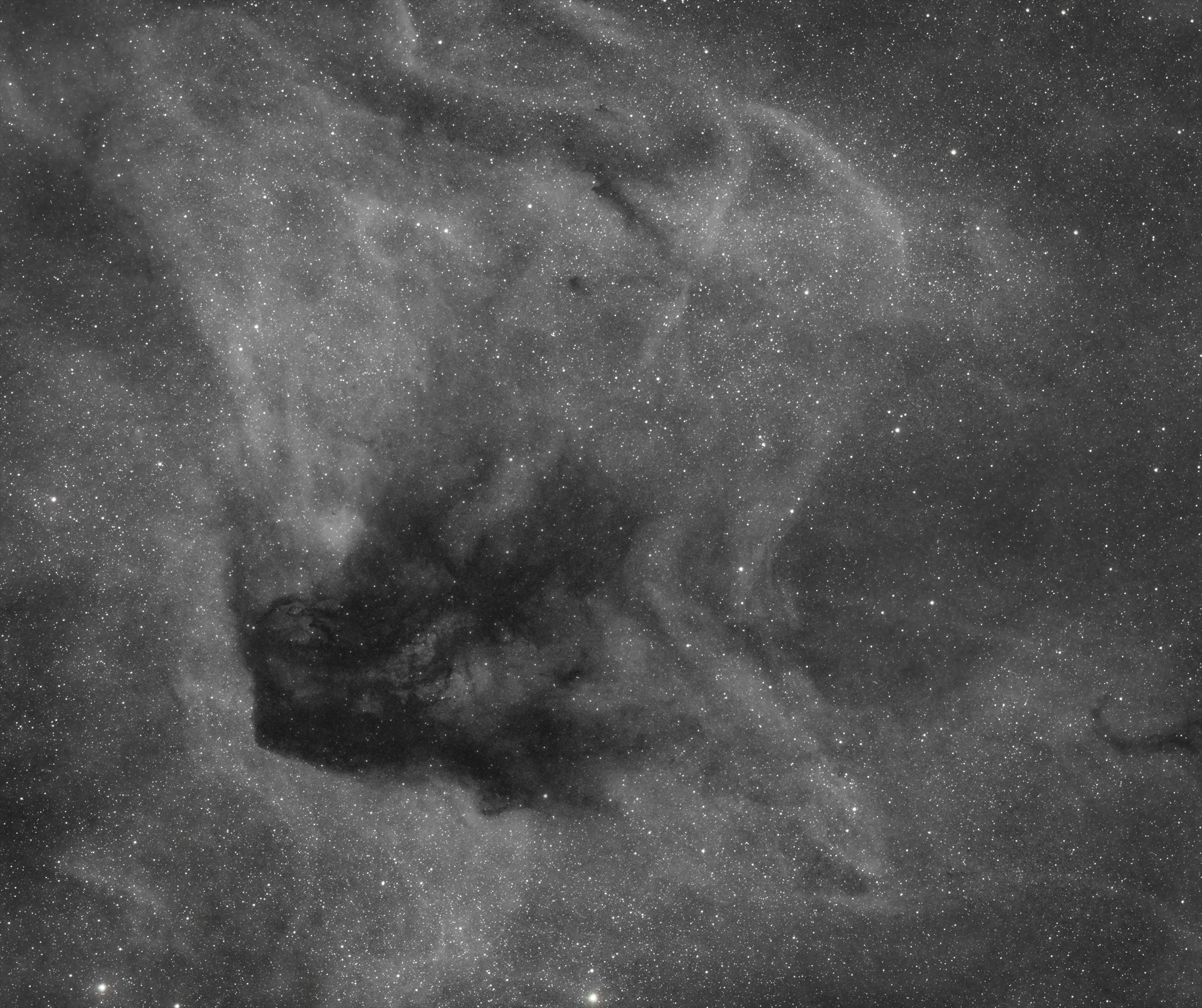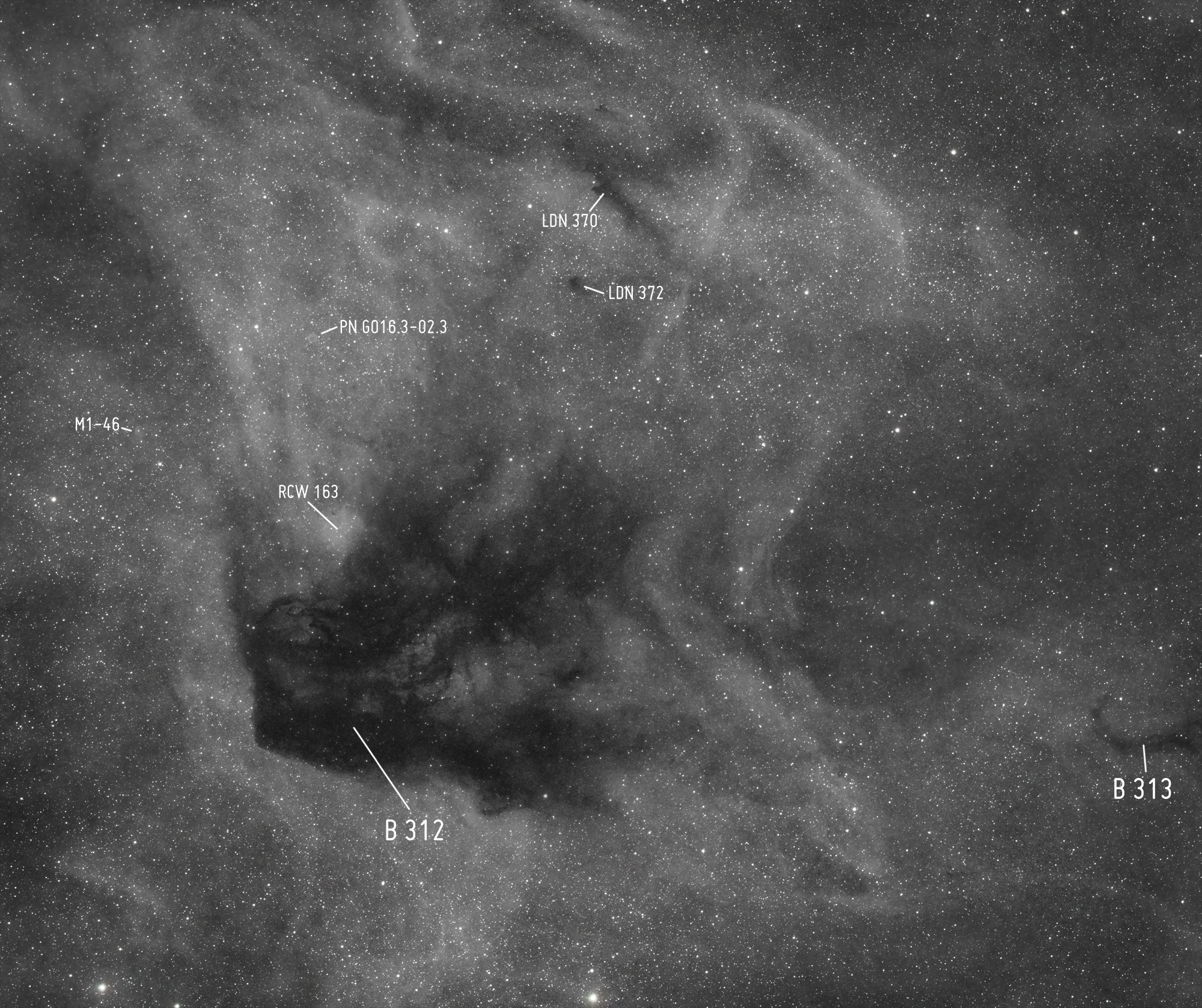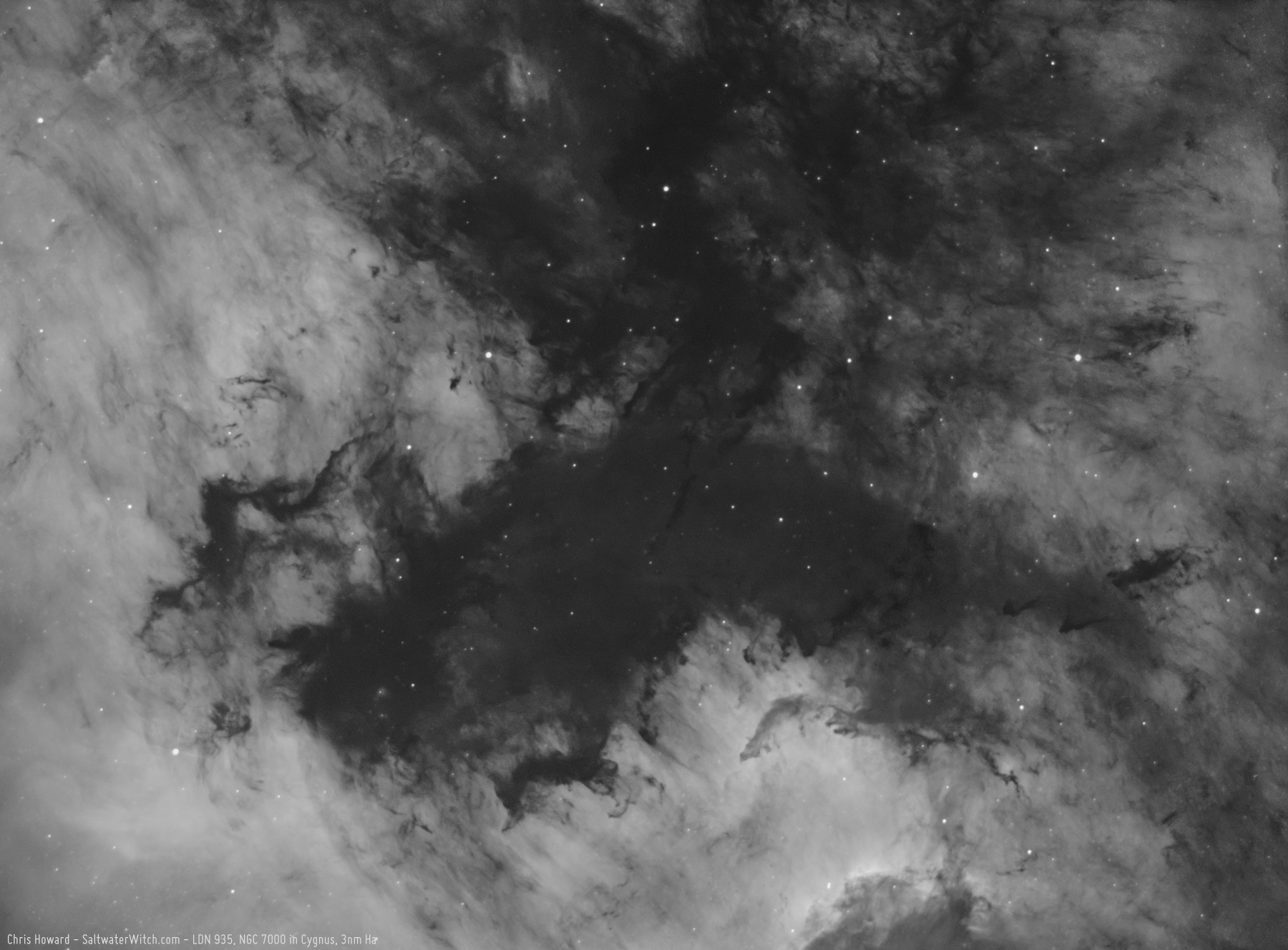NGC 7822 in Ha + OIII
Playing around with pixelmath in PixInsight with my narrowband data of NGC 7822, Cederblad 214, an emission nebula in Cepheus, about 3,000 lightyears away. This is Hydrogen-alpha (Ha) combined with Oxygen 3 (OIII) data I captured over several weeks, made up of 52 x 300-second exposures of Ha and 32 x 600-second (10 minute) exposures of OIII. Gear notes: William Optics Space Cat 51 (250mm FL @ f/4.9), ZWO ASI2600MM-Pro monochrome camera cooled to -10C, Sky-Watcher EQ6-R Pro mount, William Optics 32mm/120mm FL guide scope + ZWO ASI290MM-Mini guide camera.
Target Notes: NGC 7822, Cederblad 214, SH2-171 (the brighter emission nebula core) as well as the star cluster Berkeley 59. There are several long chains and clumps of dark nebulae, including LDN 1268, 1275, Dob 3637, 3627, 3623, many more. Nestled in that large band of dark nebulae toward the bottom is the reflection nebula GN 23.56.1. The very small circle of gray at the top left, blending in but dimmer than the nearby stars, with less contrast, is the planetary nebula Abell 1 (PLN 119+6.1). Find all of this—the nebulae and star forming complex in Cepheus near the edge of Cassiopeia.
Posted September 20, 2023
First Light with the ZWO ASI2600MM Pro mono camera
June and July consistently delivered terrible weather for astronomy—here in the northwest US. There was one clear-ish night somewhere in the middle of the waves of thunderstorms, torrential rain, and general cloudiness, but on that one night we were close to a full moon and a few hours of clear skies amid the weeks of cloud that followed that night wasn’t worth the effort. So I waited for the next opportunity. Last night, August 11th, I set up the Sky-Watcher mount (EQ6-R Pro) with the William Optics SpaceCat and my new camera, which I bought in June.
Here's the result of my first imaging run with the ZWO ASI2600MM Pro mono camera, cooled to -10C, Antlia 3nm Hydrogen-alpha Pro Imaging filter (2 inch). 52 x 300-second sub-exposures with minimal calibration (bias & dark, no flat frames). The ASI2600 is built around the monochrome version of the Sony IMX571 APS-C sized sensor, and although you can get away with 36mm unmounted filters, I went all the way to 2 inch mounted narrowband filters. And not even a hint of vignetting. I didn't use flat frames when stacking. So, am I impressed with the ZWO ASI2600MM Pro? Oh yeah.
I started narrowband imaging about ten years ago with Atik mono CCD cameras, moved through a couple QHYs, and settled on the ZWO ASI1600MM Pro—the smaller, older generation of this ASI2600. I've been using the 1600 for four or five years, and it was time to upgrade. The 2600 has been out for a little while—I'm not new to this camera but I'm really glad I made the jump.
Target Notes: NGC 7822, Cederblad 214, SH2-171 (the brighter emission nebula core) as well as the star cluster Berkeley 59. There are several long chains and clumps of dark nebulae, including LDN 1268, 1275, Dob 3637, 3627, 3623, many more. Nestled in that large band of dark nebulae toward the bottom is the reflection nebula GN 23.56.1. The very small circle of gray at the top left, blending in but dimmer than the nearby stars, with less contrast, is the planetary nebula Abell 1 (PLN 119+6.1). Find all of this—the nebulae and star forming complex in Cepheus near the edge of Cassiopeia.
Click for full view:
Posted August 12, 2023
Sadr Region (Northeast)
Sadr Region (Northeast) in Cygnus, with a batch of HII regions and dark nebulae, including IC 1318A, LBN 251, DWB 82 (all refer to the large, bright triangular mass at the top right), scattered lumps of dark nebula, including LDN 894, 892, 891, Dobashi 2429, 2468, 2449, et. al. This is probably it for a little while. We have five or six days of rain storms headed our way, and a waxing moon right along with it.
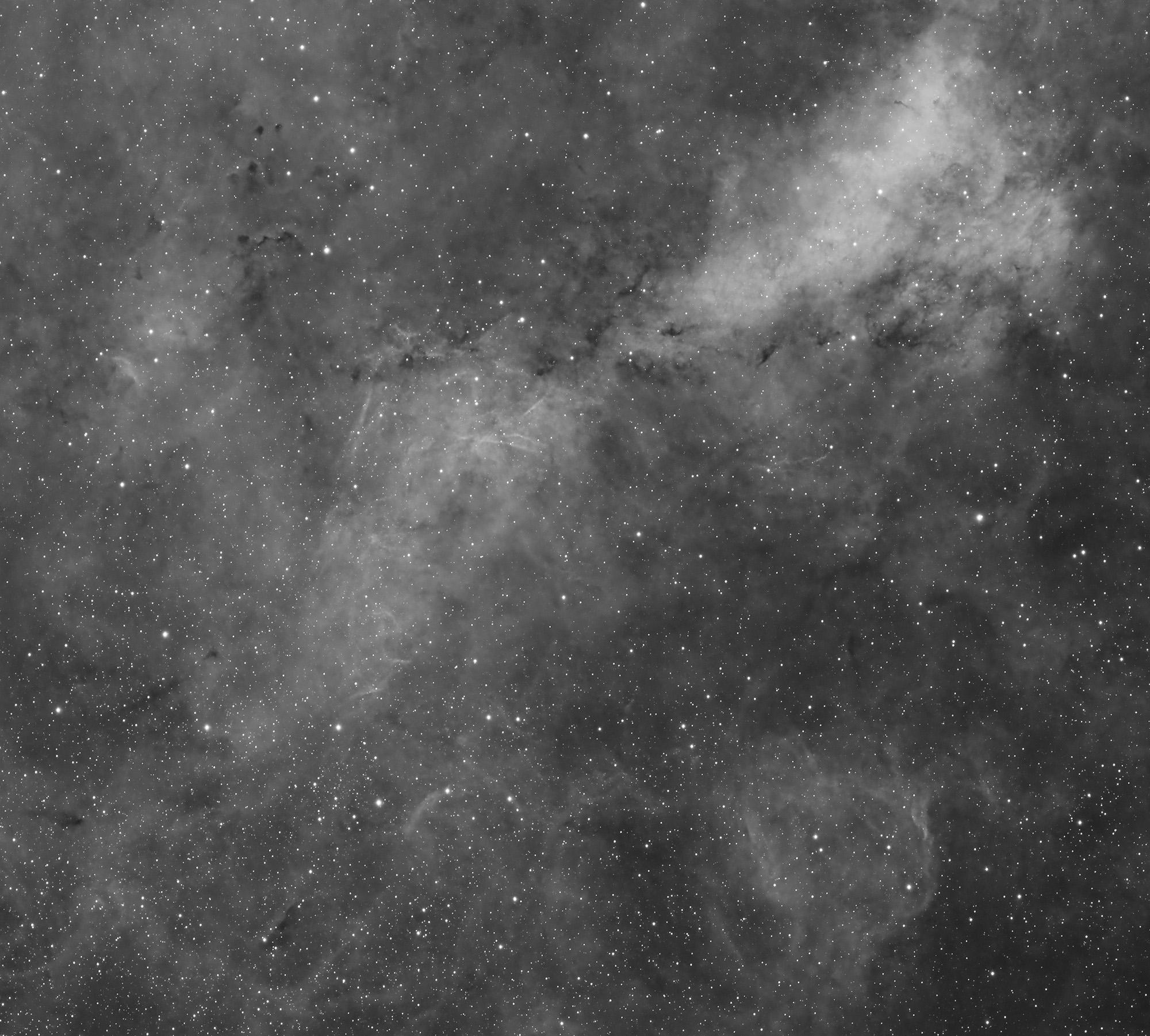
Posted June 23, 2023
Starless NGC 7000 Narrowband
The Cygnus Wall in NGC 7000 (Caldwell 20), the North America Nebula in the constellation Cygnus. These clouds of molecular hydrogen and oxygen are about 2600 lightyears away from us, and to provide some scale, this frame is about a hundred lightyears from one side to the other, or about 600 trillion miles or 950 trillion kilometers. Notes: stars removed with StarNet2 to highlight the softer wisps of dark nebulae scattered in front of the bright emission nebula beyond.
Posted June 12, 2023
B312, B313, and planetary nebulae PN G016.3-02.3 and M1-46 in Scutum
Dark nebulae B312, B313, and planetary nebulae PN G016.3-02.3 and M1-46 in Scutum. 36 x 240-second Ha subs with the William Optics GT 81 and ZWO ASI1600MM-Pro monochrome camera.
Posted June 7, 2023
Dark Nebulae in Cygnus, 3nm Ha
LDN 935, 933 (dark nebulae), the "Gulf of Mexico" region of NGC 7000, the North America Nebula in Cygnus.
Dark nebula Dobashi 2961, et al. below the North America Nebula, 3 nanometer hydrogen-alpha:

Atlas and Catalog of Dark Clouds Based on the 2 Micron All Sky Survey
Kazuhito Dobashi, Publications of the Astronomical Society of Japan, Volume 63, Issue sp1, 25 January 2011, Pages S1–S362, https://doi.org/10.1093/pasj/63.sp1.S1

Posted May 31, 2023
NGC 6888 without stars
NGC 6888, the Crescent Nebula in Cygnus (stars removed). Apertura 800mm f/4 newtonian, 28 x 300 exposures with the ZWO ASI071MC cooled to -10C, Optolong dual-band l-eXtreme filter with 7nm bandpasses at Ha and OIII, Sky-Watcher EQ6-R Pro mount, William Optics 32mm/120mm FL guide scope + ZWO ASI290MM guide camera. The Crescent is close to 5000 lightyears away, about 25 lightyears across at its widest point, roughly 237 trillion kilometers wide (150 trillion miles). The dense clouds of oxygen and hydrogen are lit up with the intense radiation of a central star; the whole structure is expanding and accelerating away energetically, very bright against the velvety bed of ionized hydrogen that spans most of the constellation Cygnus. With the stars removed from the image, NGC 6888 almost looks solid instead of a vast bubble of interstellar gas and dust.

Posted May 30, 2023
NGC 6820 (Sh2-86) in Vulpecula
Nebula NGC 6820 (Sh2-86) in the constellation Vulpecula, surrounding the open star cluster NGC 6823. 48 x 300-second subs in 3nm Hydrogen-alpha. The intense radiation from that central cluster of stars is hollowing out the nebula, pushing the gas and dust in all directions, creating pillars of trailing material where energetic star light meets dense pockets of gas, or faster cooling heavy elements with higher inertia. Everything in that rough circular area in the bottom right is accelerating away from those bright and very hot stars in the center. I believe the dark nebulae across the middle and top are part of Dobashi 2045? (I really want to know the story with that weird faintly-backlit tail of interstellar dust at the lower left. Definitely something cool going on there).
Interesting info on the formation of pillars and "elephant trunks" in nebulae:
Jonathan Mackey, Andrew J. Lim, Dynamical models for the formation of elephant trunks in H II regions, Monthly Notices of the Royal Astronomical Society, Volume 403, Issue 2, April 2010, Pages 714–730, https://doi.org/10.1111/j.1365-2966.2009.16181.x
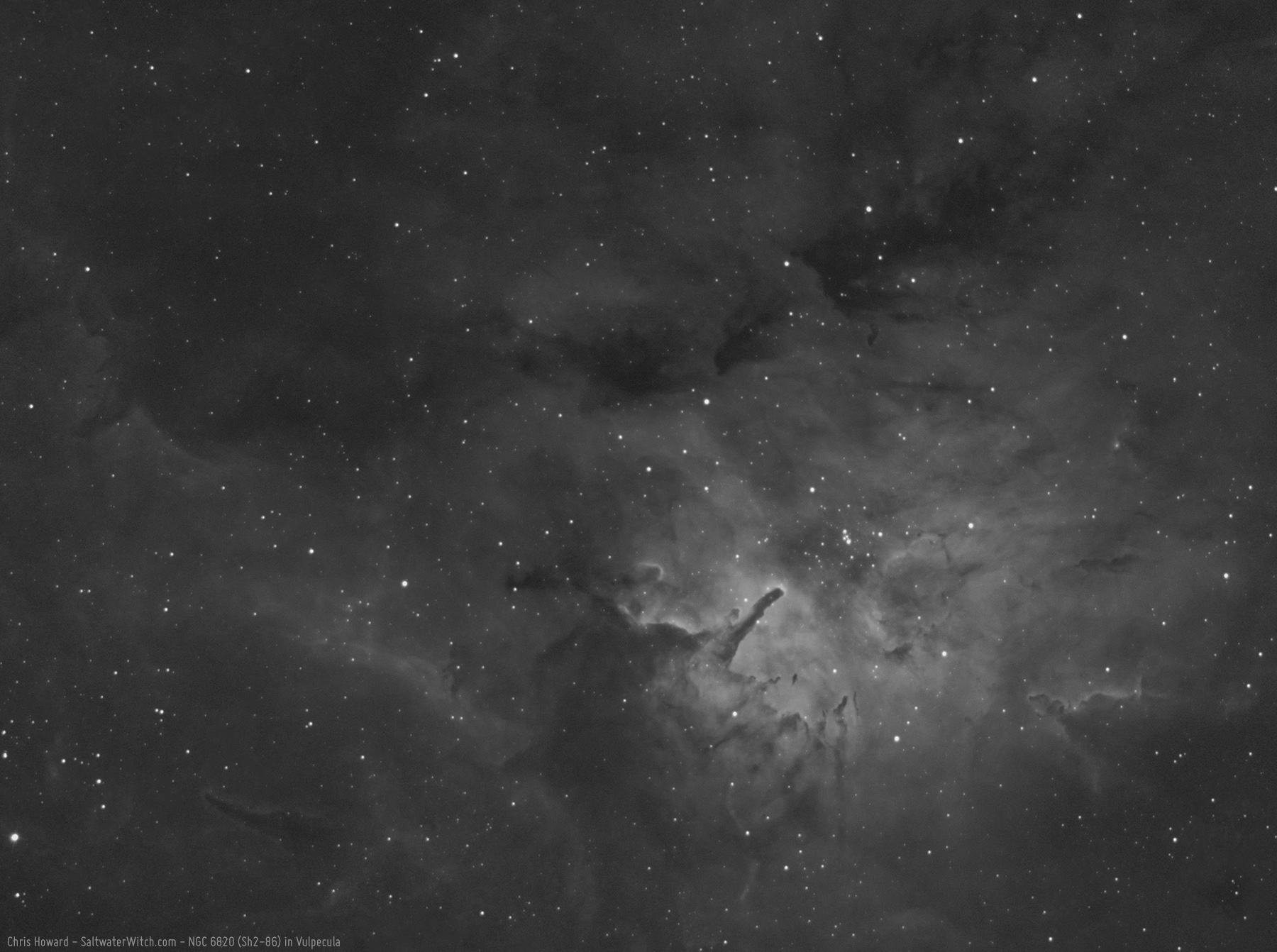
Went back last night and captured 48 subs of OIII:


